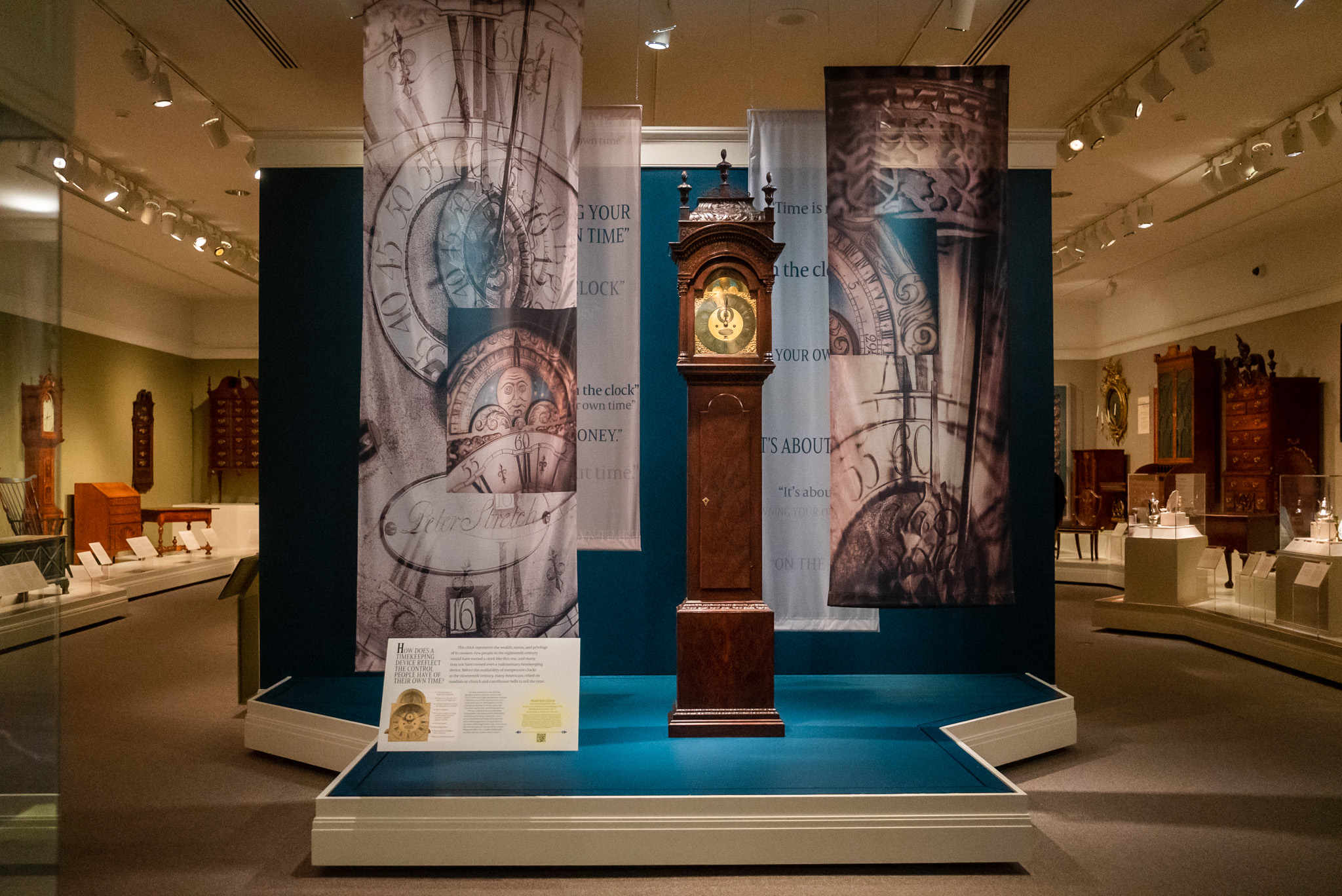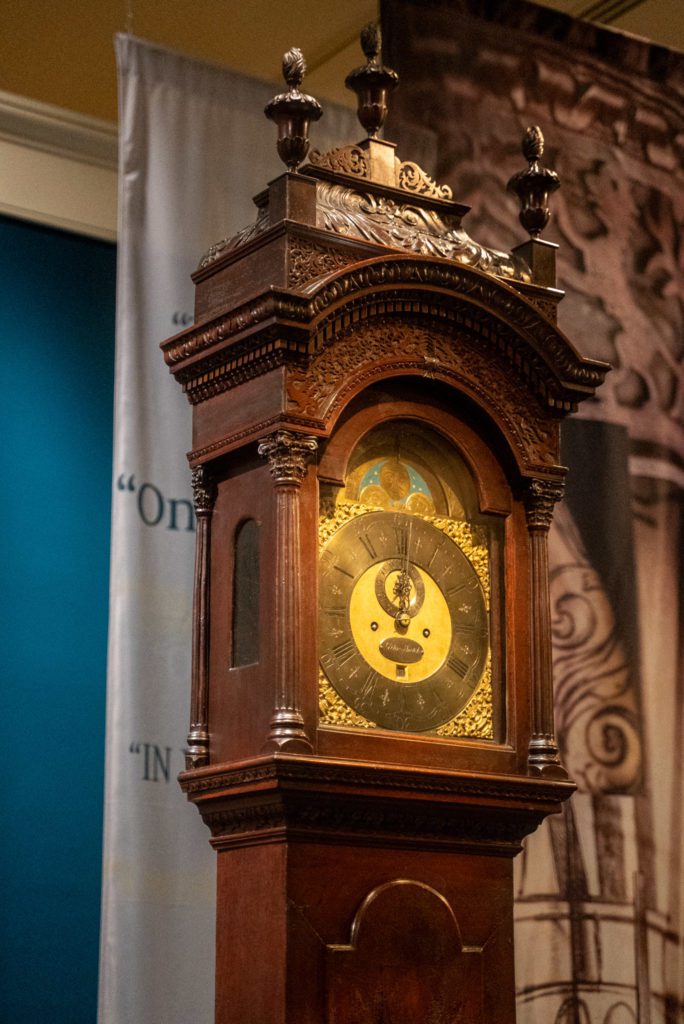This towering clock by the renowned Peter Stretch stands as the most beautiful example of a tall case clock ever made in America.
Many would call it a grandfather clock, but the label would hardly do it justice, as demonstrated by its place of pride in a space already filled with premium examples of exceptional American craftsmanship.
Walk through the main gallery entrance, turn left, and there it stands front and center. The clock was made between 1730 and 1745 by leading clockmaker Peter Stretch of Philadelphia. It was commissioned by merchant Clement Plumsted (1680-1745) or his son, William Plumsted (1708-1765), to make an impression.

“He’s saying, ‘I am a man of means. I have a lot of capital at my disposal. I’m successful. I can command these resources. I can order, pay for, and ship the mahogany. I have that that global power at my fingertips,’” says Josh Lane, the Lois F. and Henry S. McNeil Curator of Furniture.
One of about 60 known examples of clocks by Stretch, Winterthur’s clock stands out. The heart of the object is the eight-day, weight-powered works. The arched brass dial is beautifully engraved with urn, bird, and fleur-de-lis motifs and the corners are embellished with cast brass spandrels. Roman and Arabic numerals on the large chapter ring mark hours and minutes and Arabic numerals on a small chapter ring mark seconds. A small square aperture reveals the day of the month. A moon phase dial with numbered edge shows the waxing and waning of the moon and timing of the tides. An oval plate bears the engraved signature of the maker.
“The movement has all the bells and whistles that you would expect a Philadelphia-based merchant would want,” Lane says. “The tide dial is geared toward Philadelphia mercantile ocean-going activity. There were other, more complicated and more expensive works made in the period, but it’s the combination of this movement in this case that puts it over the top. It is probably the most elaborate and beautiful case ever made in America.”
Standing more than eight feet tall, the case is distinguished by magnificent carving. An arched hood is surmounted by an ogee sarcophagus top carved with floral and foliate designs surmounted by three flame-and-urn finials. The cornice molding features egg-and-dart carved molding, dentil course, and blind fretwork incorporating the Plumsted coat of arms supported by rampant lions. Colonnettes with Corinthian capitals grace the sides of the hood.
The exact identity of the case maker is not known, but it may be Philadelphia cabinetmaker John Head, based on comparison with other examples of his work. Stretch may have worked with the cabinetmaker directly, or Plumstead may have commissioned the case based on his desires and tastes, a common practice at the time.
“It’s very elaborate, over-the-top, expensive, time-consuming workmanship,” Lane says. “The clock is really an extraordinary architectonic statement. No other compares.”

Born in England, Peter Stretch (1670–1746) learned his trade there and then immigrated to Philadelphia in 1702. He quickly became the city’s most prominent clockmaker and was commissioned by Philadelphia’s Common Council to work on the town clock in 1717. His sons followed him into the trade, although they were not as prolific.
Stretch’s shop stood across Chestnut Street from the Plumsted home. This clock remained in the Plumsted family until it was purchased by a private collector in 1943. Winterthur acquired the clock at auction in October 2004.
So why do we call such amazing tall clocks “grandfather clocks,” when it seems as though the term sometimes diminishes their beauty and importance? Thank a wave of nostalgia for the early days of the Republic, after the American Civil War, when people left the cities for new opportunities across the expanding country, and new value was placed on old objects. When popular composer and songwriter Henry Clay Work penned “The Grandfather Clock” in 1875, it forever changed the common name of the tall case clock:
My grandfather’s clock was too tall for the shelf
So it stood ninety years on the floor
It was taller by half than the old man himself
But it weighed not a pennyweight more
It was bought on the morn that my grandfather was born
And was always his treasure and pride
But it stopped short, never to go again
When the old man died.
Museum Purchase with funds provided by the Henry Francis du Pont Collectors Circle, the Centenary Fund, Mrs. C. Lalor Burdick, Mr. and Mrs. Richard L. Chilton, Jr, Mrs. Robert N. Downs III, Mr. William K. du Pont, Mr. and Mrs. Frederick C. Fiechter III, Mr. and Mrs. John A. Herdeg, The Hohmann Foundation, Family of Mr. and Mrs. Walter M. Jeffords, Jr, Kaufman Americana Foundation, Mrs. George M. Kaufman, Mr. and Mrs. Barron U. Kidd, Charles Pollak, Peter A. Pollak, Suzanne W. Pollak, Mr. and Mrs. P. Coleman Townsend, Jr, anonymous donors (2), and numerous friends.
To learn more about this clock and others made by Peter Stretch and his sons, see Stretch, America’s First Family of Clockmakers by Donald L. Fennimore and Frank Hohman III, which is available at the Museum Store, or visit the clock in the first-floor gallery.